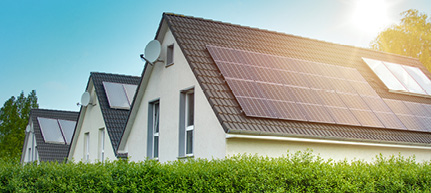Seal and Insulate Your Home

Heating and cooling account for most of the energy consumption in a typical home. If your home is experiencing moisture issues, drafts, or uneven temperatures, air sealing and insulation can help address leaks to improve comfort, air quality, and energy savings.
Having a well-insulated, weatherized home is an important step before making other energy upgrades, such as heat pumps ![]() , since a more efficient home could be sized for a smaller, lower-cost system.
, since a more efficient home could be sized for a smaller, lower-cost system.
Completing a no-cost home energy assessment can help you better understand how well your home is sealed and insulated. During the assessment, a home performance contractor can evaluate and determine the appropriate levels of insulation, air sealing, and ventilation for your home.
Programs and Incentives
-

Comfort Home Program
Learn More Comfort Home ProgramGet incentives for installing “seal and insulate” packages and high-performance windows from a qualified contractor.
-

EmPower+
Learn More EmPower+Income-eligible New Yorkers can receive incentives for no- and low-cost energy efficiency improvement to save energy and boost home comfort.
-

Inflation Reduction Act
Learn More Inflation Reduction ActExplore IRA tax credits for insulation materials, windows, and exterior doors, plus eligibility requirements for homeowners.
Hire a Contractor
To achieve the best results, we recommend working with a professional contractor to complete a home energy assessment. Through an assessment, contractors can look at air sealing and insulating your home holistically, as well as identify other energy-saving opportunities.
Do-It-Yourself Projects
There are many small, simple steps you can take to improve the air sealing of your home. First, identify where potential trouble spots in your home may be for air leaks (such as window frames, outlets and switches, and exterior door frames). Second, identify whether you can address the problem areas on your own. Some opportunities may include weatherstripping windows and doors, pull-down stairs, and attic entrances.
Discover ENERGY STAR® air sealing energy-saving tips ![]() .
.
You Might Also Be Interested In
- NYS Clean Heat
 : Provides guidance and incentives to homeowners toward the installation of clean heating and cooling equipment, including cold-climate air source heat pumps (ASHP), ground source heat pumps (GSHP), and heat pump water heaters (HPWH).
: Provides guidance and incentives to homeowners toward the installation of clean heating and cooling equipment, including cold-climate air source heat pumps (ASHP), ground source heat pumps (GSHP), and heat pump water heaters (HPWH). - NY-Sun: Offers programs to reduce the costs of installing solar panels and make clean energy more accessible to all New Yorkers through community solar projects.
- Energy Storage: Provides back-up power to your home and reduces the cost of your electric bill, especially when paired with a solar energy system.
Sign Up For News
Stay up to date on energy-saving programs and incentives, best practices, and more.
Stay Connected
